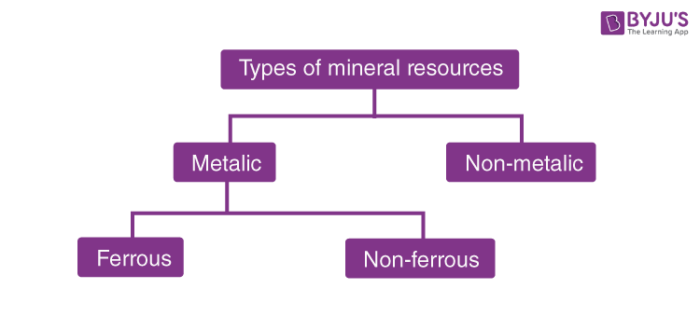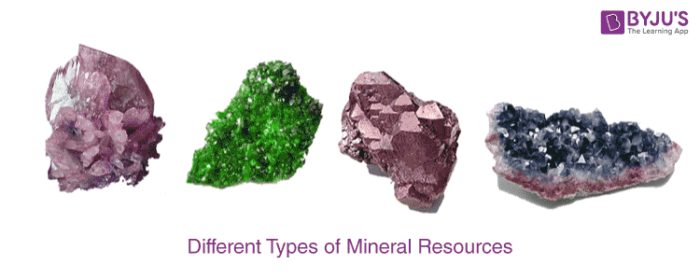Explain the Different Types of Minerals
They include calcium phosphorus magnesium sodium potassium chloride and sulfur. A basic classification for minerals is.
This method is best suited for mineral deposits that are close to the surface of the earth but are not accumulated in a horizontal manner.

. You need larger amounts of macrominerals. Ores are the minerals from which metal is conveniently and profitably extracted. The oxygen and silicone found in silicates.
Each mineral has its own chemical formula. Examples include pyrite FeS 2 galena PbS and sphalerite ZnS in. Therefore materials such as.
Georgius Agricolas classification of minerals in his book De Natura Fossilium published in 1546 divided minerals into three types of substance. These minerals are not in metallic form and they do not contain metal. Ivory Amber Coal Pearls are not minerals.
Some minerals have a different colored streak than the color of their body. This gives them a shiny luster. Organic minerals include all types of oxalates mellitates citrates cyanates acetates formates hydrocarbons etc.
Rocks and minerals are important for learning about earth materials structure and systems. What are the different types of ores. Metallic Minerals Metallic minerals exhibit lustre in their appearance and consist of metals in their chemical.
Minerals are classified into two types. Studying these natural objects incorporates an understanding of earth science chemistry physics and math. Discover the types properties and examples of minerals as well as the importance of.
Common minerals include quartz feldspar bauxite cobalt talc and pyrite. Open-pit mining often impacts a narrower surface area. All minerals have a specific chemical composition.
What is mineral ore used for. Metallic minerals have metal in them. A gem is a piece of rare mineral such as diamond emerald or sapphire that is cut and polished to shine.
Igneous rocks crystallizing from molten material sedimentary rocks composed of products of mechanical weathering sand gravel etc and chemical weathering things precipitated from solution and metamorphic rocks produced by alteration of other rocks by heat and pressure. Different Types of Minerals 1. Simple stones earths metals and congealed juices compound intimately mixed and composite separable.
There are two kinds of minerals. Silicate minerals are the largest class of minerals while non-silicate minerals vary greatly with regard to structure and composition. Minerals being natural chemicals are classified according to their chemistry and crystal form.
Some minerals are even used to make hormones or maintain a normal heartbeat. Types of Mineral Resources. As is discussed in later chapters there are three types of rocks composed of minerals.
Metallic Minerals Metallic minerals have lustre property in their appearance and they consist of metals in their. There are mainly four kinds of ores like Ores Oxides. You only need small amounts of trace minerals.
These are based on the sulfide ion S 2. Most minerals in the earths crust. This class of minerals includes biogenic substances genesis or origin of which can be attributed to a geological process.
Minerals like Gypsum CaSO 4 2H 2 O and Barite BaSO 4 are examples of sulfate minerals. This article throws light upon the six main types of clay minerals. How Many Types of Minerals.
Examples are iron ore manganese ore chromite pyrite nickel and cobalt. Halite pictured in the Figure 22 above is NaCl sodium chloride. Calcium is the top mineral when it comes to your bones.
Minerals are solids that are naturally formed with a unique chemical composition and a crystalline structure. Open-pit mining is the activity of removing the earth to access the mineral deposits and continuing to do it vertically in an open-pit. This mineral helps build strong bones so you can do everything from standing up straight to scoring that winning goal.
The mineral silver is made up of only silver atoms and diamond is made only of carbon atoms but most minerals are made up of chemical compounds. Scientists usually begin by separating minerals into two groups. Important among them are 1.
Different Types of Minerals. Minerals in general have been categorized into three classes fuel metallic and non-metallic. Fuel minerals like coal oil and natural gas have been given prime importance as they account for nearly 87 of the value of mineral production whereas metallic and non-metallic constitutes 6 to 7.
The two main groups of minerals are the silicates which are formed from oxygen and silicone and the non-silicates which are not composed of silicone and oxygen. Certain minerals are needed by our bodies so we can grow healthy and strong. Ore is a deposit of one or more precious minerals in the Earths crust.
Gold Silver Mercury graphite diamond. Macrominerals and trace minerals. Minerals are classified into different types on the basis of nature texture and sues.
The learner can walk away with an understanding of crystal geometry the ability to visualize 3-D objects or knowing rates of crystallization. Based on the polyatomic anion SiO 4 4 which has a tetrahedral shape. Lets take a closer look at some of the minerals you get from food.
A few non-metallic minerals are Mica Asbestos Sulphur lead Zinc Phosphate etc. These are based on. Minerals Naturally Occurring - minerals must be formed naturally - glass concrete synthetic diamonds rubies and emeralds dont count Inorganic - minerals are not formed by anything that was ever alive.
They are further sub-divided into ferrous and non-ferrous. They contain metals other than iron.

Types Of Minerals Definition Classification Examples With Videos

Rocks And Minerals Indiana Geological Water Survey

Types Of Minerals Definition Classification Examples With Videos


Comments
Post a Comment